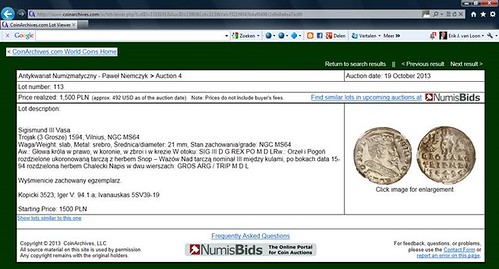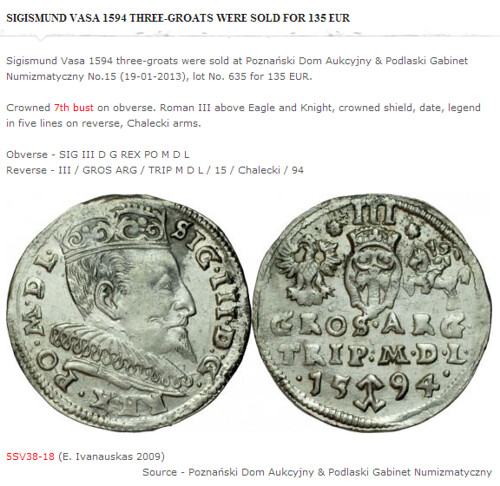
PREV ARTICLE
NEXT ARTICLE
FULL ISSUE
PREV FULL ISSUE
EUROPEAN COINAGE 1500–1600 REFERENCE CATALOGS
Several readers responded to Seth Wilson's question about reference books on European coinage from 1500 – 1600;
-Editor
Ken Bressett writes: Another nice edition of The E-Sylum to start my week. Thanks for all your dedicated work. It is very much appreciated. Regarding the 1594 coin in question. It is from Poland and is a three groschen silver piece of King Sigismund III who ruled 1587-1632. Good general references on coins from 1500-1600 are probably scarcer than the coins. Jim Duncan of New Zealand writes: European coinage? Try Saurma - in full "Die Saurmasche Munzsammlung". Goes up to 1620. Almost all pix, easy to follow. Dave Hirt writes: Information on the dollar size coins is easy: Davenport, or several books on World Dollars. But on the minor coins, not so easy. You probably need a special book on the country of the coin. David Powell writes: Seth's piece is a Polish trojak, or three groschen, of Sigismund III of Poland. The mark at the bottom, flanked by the date, indicates that it comes from the Lithuanian mint. 16th and early 17th cent Polish small silver is an interesting series, with plenty of minor varieties and often quite moderately priced. Regarding books on European coinage pre-1600, two general rules:
One of the challenges of European pieces of this date is finding just what books are out there to go with them. If they are highly pictorial and not text-heavy, their not being in English is not always too great a problem. Pictures and numbers are the same in most Western languages, and if accompanied by plenty of one-line descriptions you will probably pick up some relevant vocabulary as well, by process of deduction and/or elimination. A few recommendations for various countries, based on my own bookshelf: Poland: "Monety Dawnej Polski" by Ignacy Zagorski {Warsaw, 1969}. Modest paperback catalogue with very little text, but over 800 superb line drawings. Period covered 1506 to the 1790s; ideal for exploring the varieties and the different mints. Picked mine up for £10, c.1990; excellent value. "Pieniadz na Ziemiach Polskich, X-XX w." , by Jósef Andrzej Szwagrzyk, pub.1973 - heavier going, more text, but plenty of tables and listings; quality of photography rather moderate; covers 10th to 20th cents. France: "Les Monnaies Françaises Royales" by Jean Duplessy, in two volumes, pub.1989. Plentiful photographs and line drawings; Vol.1 covers 987-1515, Vol.2 covers 1515-1793. For provincial issues use E.Boudeau's "Monnaies Françaises Provinciales"; an older style catalogue with a number of line drawings, but not nearly as many. Portugal: "Livro das Moedas de Portugal", by J.Ferraro Vaz and Javier Salgado. Price catalogue; line drawings of virtually everything. Date range 1128 to late 20th cent. Spain: "Numismatica Espaňola, 1474 a 1988", by Ferrán Calico, Xavier Calico & Joaquin Trigo {Barcelona, 1988}. Priced catalogue; high-quality paper and superbly illustrated, like many Spanish books. "Las Monedas Espaňolas, del tremis al euro", by Clemente Adolfo & Juan Cayon; i.e. from the tremessis to the euro, covering the period 411 to 1998. Again, priced catalogue, high quality production and superb illustrations. Sweden: "Sveriges Mynt, 1521-1977", i.e. The Coinage of Sweden, by Ahlstrom, Almer & Hemmingsson {1970s}. Price catalogue, good photography, good paper, some of the text bilingual Swedish & English. "Sveriges Besittningsmynt", i.e. Coins of the Swedish Possessions, by Ahlstrom, Almer & Jonsson {1970s}. Colonial supplement to the previous volume. Same series as last, similar style, except trilingual Swedish, German & English. Norway: "Norges Mynter" by Ahlstrom, Brekke & Hemmingsson {1970s}. Covers from Viking times. Same series as the Swedish books above, style & production almost identical; again partly bilingual. Denmark: "Danmarks og Norges Monter, 1541-1977" by Holger Hede {1978}. Good photography; no prices, but rarities given, plus extensive listing of varieties. I suspect that some of the above may have been updated, possibly in some cases by different authors, since I purchased my own copies twenty years or so ago; in certain cases I expect that they are the standard price catalogues for their respective series, and hence liable to reissue quite regularly.
Others chimed in to identify the coin we used to illustrate the article.
-Editor
James Higby was the first to respond. He writes: It's a 3 groschen from Poland, probably Danzig, and is catalogued as #1335 in Handbuch der Polonischen Numismatik by Marian Gumowski. Graz: Akademische Druck, U. Verlagsanstalt, 1960. Michael Luck and Larry Dziubek agree. Larry writes: The 1594 coin in question is a Sigismund 3rd / three groschen of Poland. It could well be Gumowski catalog # 1335. Tony Tumonis of Tucson, Arizona agrees: The coin in the photograph is a 1594 Lithuania / Poland 3 Groschen issued during the reign of Sigismund III. It is listed as catalog number 1335 in Handbuch Der Polnischen Numismatik by Marion Gumowski. Erik J. van Loon from the Netherlands found one online. He writes: If you put the text of one side of a coin into Google (I put the "III GROS ARG TRIP.M.DI. 1594") you will find answers. This was my second hit.

Eric Vanhove writes: The coin is a 3 groats of Sigismund Vasa. I did a Google search on the reverse and came up with this link: www.icoins.eu/ygimantas-vaza-1588-1632/three-groats/1594.html

Eric Schena also found examples on the coin (on the numisbids.com site). He writes: Some of these entries contain catalog references, but as far as I know, there's no standard book for pre-1600 catalog - I have always had to resort to specialized texts and auction listings. Heck, some of the post 1600 coins are not covered in the Standard Catalog of World Coins (two come immediately to mind: Russian "wire" coins and Venetian colonial coins). Dave Hirt writes: It looked like a Polish coin to me. I have an old book, Monety Dawnej Polski. It is in Latin and Polish, of which I read neither, but through the line drawings I figured out it is a coin of Sigismund III struck for Lithuania. It may be rare because my book lists several dates in the 1590's, but NOT 1594.
To read the earlier E-Sylum article, see:
QUERY: EUROPEAN COINAGE 1500–1600 CATALOG SOUGHT
(www.coinbooks.org/esylum_v16n47a08.html)
The Numismatic Bibliomania Society is a non-profit organization promoting numismatic literature. See our web site at coinbooks.org. To submit items for publication in The E-Sylum, write to the Editor at this address: whomren@gmail.com To subscribe go to: https://my.binhost.com/lists/listinfo/esylum All Rights Reserved. NBS Home Page Contact the NBS webmaster 
|